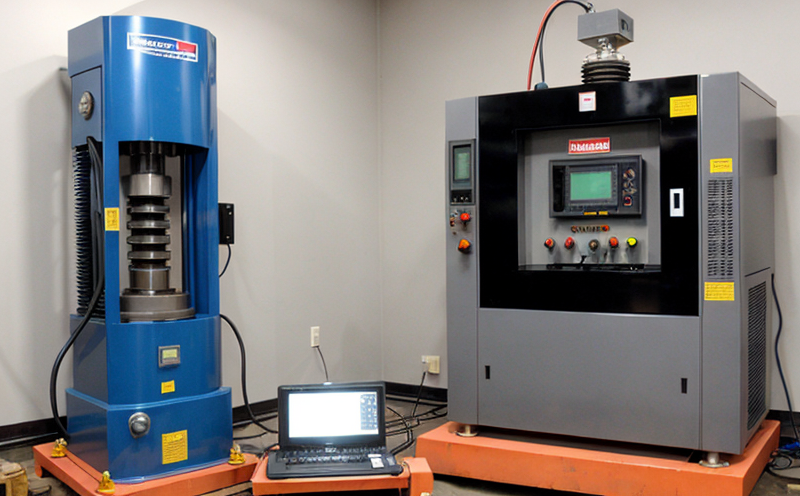ISO 7626 Experimental Vibration Analysis of Structures
The ISO 7626 standard is a pivotal framework that outlines procedures for conducting experimental vibration analysis on structures. This method is crucial in the electronics testing sector, particularly for ensuring robustness and reliability under varying environmental conditions. The process involves subjecting electronic components to controlled mechanical shock and vibration forces to simulate real-world scenarios.
The core of ISO 7626 lies in its ability to provide a standardized approach to measuring and analyzing structural responses. This is achieved by employing sophisticated instrumentation such as accelerometers, force sensors, and vibration analyzers. The testing process begins with meticulous preparation of the specimens, which involves securing them onto a shaker table using appropriate clamping fixtures.
The mechanical shock and vibration are then applied in controlled sequences to mimic potential environmental stressors that the electronic components may encounter during their lifecycle. The test setup ensures that all parameters, including frequency range, amplitude, and duration, adhere strictly to ISO 7626 standards. This allows for precise replication of real-world conditions, thereby enhancing the accuracy and reliability of the test results.
Post-testing analysis involves comprehensive data collection using advanced software tools capable of processing complex vibration signals. The generated reports provide detailed insights into how well the tested structures withstand mechanical shock and vibration. These reports are essential for quality managers, compliance officers, R&D engineers, and procurement teams as they serve as critical inputs in decision-making processes.
One key aspect of ISO 7626 is its emphasis on repeatability and reproducibility. By adhering to strict protocols, the standard ensures that tests conducted across different facilities yield consistent results. This consistency not only builds trust among stakeholders but also facilitates smoother regulatory compliance processes. Furthermore, the standardized approach helps in identifying potential weaknesses within designs early in the development cycle, thereby reducing costly rework later on.
Another significant benefit of ISO 7626 is its role in promoting innovation and improvement within the electronics industry. By setting a benchmark for what constitutes acceptable performance under specified environmental conditions, this standard encourages manufacturers to continuously enhance their products' durability and reliability. This drive towards excellence contributes significantly to the overall quality assurance efforts across the sector.
In summary, ISO 7626 provides a robust framework for conducting experimental vibration analysis of structures in electronics testing. Its rigorous methodology ensures accurate assessment of mechanical shock resistance capabilities while fostering innovation through continuous improvement practices.
- Mechanical Shock: Simulation of sudden impacts to assess structural integrity.
- Vibration Analysis: Measurement and evaluation of responses to oscillatory forces.
- Data Collection: Utilization of advanced instrumentation for precise measurements.
- Report Generation: Comprehensive analysis leading to detailed performance reports.
Industry Applications
The application of ISO 7626 in the electronics testing sector spans various industries, including consumer electronics, automotive, aerospace, and medical devices. In consumer electronics, this standard helps ensure that products can withstand everyday use conditions without compromising safety or functionality.
In the automotive industry, adhering to ISO 7626 ensures that electronic systems within vehicles are resilient enough to endure harsh driving environments such as potholes or rough roads. Similarly, in aerospace applications, where reliability is paramount due to extreme operating conditions, compliance with this standard guarantees enhanced performance and longevity of onboard electronics.
The medical device sector also benefits greatly from ISO 7626 by ensuring that critical electronic components within devices function reliably under specified shock and vibration levels. This not only enhances patient safety but also improves overall product quality.
Across all these industries, the implementation of ISO 7626 fosters a culture of continuous improvement and excellence, driving innovation while maintaining high standards of quality assurance.
Eurolab Advantages
At Eurolab, we pride ourselves on offering comprehensive services that go beyond mere compliance with international standards like ISO 7626. Our team of experts is dedicated to providing unparalleled support throughout every stage of the testing process.
We leverage state-of-the-art facilities equipped with cutting-edge technology tailored specifically for experimental vibration analysis according to ISO 7626 guidelines. This ensures that our clients receive accurate, reliable results that reflect true real-world conditions.
Our commitment extends beyond just meeting standards; we strive to exceed expectations by delivering timely reports accompanied by expert interpretations. Our experienced engineers collaborate closely with customers to understand their unique requirements and tailor solutions accordingly.
We also offer additional value-added services such as product optimization recommendations based on test outcomes, helping our clients make informed decisions that enhance both performance and cost-efficiency.





